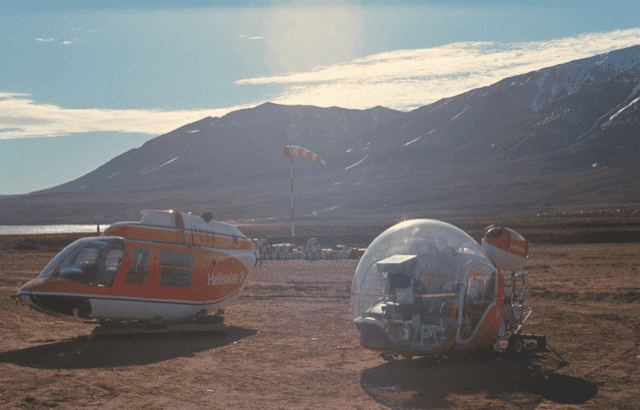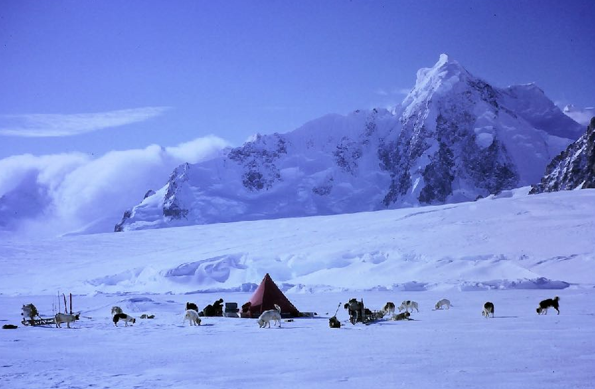An Erratic Homecoming (There is life after BAS) (continued)
The BBC wanted to come aboard for interviews and were told the price was some booze, but they came out next morning without any. Much of the questioning in the interviews seemed to be directed towards finding and laying blame (sensationalising) the five fatalities (3 at Halley and 2 at Stonington) we had suffered during my two years and there was much letting off of steam, although the edited versions broadcast that evening were very much toned down and not at all unreasonable. BAS office, I later heard, were not at all impressed, but I did have a tape recording of the broadcast from which I could draw my own conclusions.
At the appointed hour on 18th May we duly berthed, the dog was winched ashore in a quarantine cage for his 6 months incarceration to prevent any escape of the dangerous diseases he might have brought from Antarctica, (see in “Of Dogs & Men” for a bit more on that story) and I made my way home by car, reaching terrifying speeds of up to 50mph on the main roads. It all seemed quite noisy, frenetic, and depressing after so long away. Twenty four hours in Monte hadnt really been much of a preparation. No girl friend either (I had had my “Dear John” back in midwinter 1966). Four weeks of home leave loomed, with nothing much to do except sort out photos and try to survive a terrible feeling of anticlimax; nothing but six months in Birmingham to look forward to after that. What a prospect!
One day, after a couple of weeks or so of this readjusting, and right out of the blue, I received word via friends in SPRI, Cambridge that an aircraft salvage company was looking for a ‘polar expert’ at very short notice; was I available and interested. Yes, Yes. I went for interview at SPRI the next day and from there to Gatwick where I was promptly hired and installed in pilot’s lodgings next to the airfield perimeter. My brief the following day was to fly up to Edinburgh (after some discussion with Maurice and other BAS equipment experts) and, with a blank cheque, go to Graham Tiso’s new shop to purchase whatever was needed, flying it all back to Gatwick with me as excess baggage.
To pick up the converging thread of this ramble, on 27 February 1967 (as I was leaving Stonington) a brand new Aero Commander 580 aircraft on a delivery flight from North America had got lost in poor visibility over the Greenland icecap (a very common occurrence during and after WWII) and had belly landed. After two days of feeling cold, the pilot was picked up unharmed. An aircraft company had meanwhile acquired the salvage rights to the nearly new plane and planned to go and retrieve it, with me along as polar advisor doubling up as leader. If the salvage team couldnt repair and fly the plane off, I would have to get them down off the ice cap on foot. They had their own twin-engine plane (similar to the stranded one) to get us to Greenland and so all the equipment together with my own ex BAS gear were loaded on board ready to fly up to Kulusuk in East Greenland at short notice. From there we and the equipment would be flown by helicopter up to the crash site. Les, the engineer had fitted long range tanks in our own plane and these needed testing, so I was sat in the right seat and we flew over to Biggin Hill.
“OK Les” from Bob the pilot.
Dead silence. Literally. Both engines had stopped.
Mutterings and scrabblings from Les in the back, and before I had even had time to break into a sweat, both engines were restarted and the pilot Bob professed himself happy with the trials once Les had explained the hitch. They were both consummate professionals and I soon had great confidence in them. When they said they would extricate the downed aircraft in Greenland with inflatable bags under the wings and large heaters to thaw the engines out and restart them, I trusted them implicitly.

However, a major snag arose. Back at Gatwick, we were told that the helicopter in East Greenland, on which we were depending for airlift from Kulusuk up to the crash site, was grounded with mechanical problems. There was no other means of landing alongside the crash with all our clobber, so everything was put on hold. I was told I could do anything I liked so long as I was within an hour or two of our plane which sat on the tarmac at Gatwick, fully loaded and ready to go. It was no hardship really, though a bit frustrating. I was in plush lodgings, all expenses and salary paid, and there was always something going on in or around the hangers. The cabin crews, mainly Laker, often brought in surplus food and drink, and there were always test and maintenance servicing flights on which to scrounge a ride. Decca navigation test flights out over the Atlantic for example. There was even a works Twin Otter there for demo flights and I managed to arrange one of these for BAS HQ to which the Director and one or two other VIP’s came out. BAS later adopted the Twotter, as is well known. On one such flight, the pilot demonstrated the short landing capability by landing across the taxi-way instead of on the main runway. Highly spectacular, but I believe he got a row from the aircraft control tower afterwards. In those days Gatwick was only a small regional airport.
Post-Antarctic life was beginning to look up. The boss’s secretary was good company on many such ‘jollies’, but we were too late for the best. Both of us had seen, on the boss’s desk, complimentary tickets for the latest James Bond premiere in London, but neither of us had the nerve to ask about them. It turned out that they were tickets for the pilot, Bob, who had done stunt flying for the film, and we could have had them for the asking because he couldn’t go. Oh well; you can’t win them all, but it would have been a good tick – a West End Bond premiere (You Only Live Twice) partnering the boss’s secretary! Just the sort of normality a returning Fid needed!
To cut a long story much shorter, the Greenland helicopter remained out of action for ages and another air salvage company took over the salvage contract. I was left in the dark to start with, but the new pilot and crew decided to take our plane (without me) and fly up to Kulusuk to see for themselves what was going on. When they got there, the weather was excellent and they decided to fly on up to the icecap to take a look. The weather clagged in rapidly, as is quite common there. The pilot did a low pass around the wreck even though it was by then near whiteout, lost his horizon and crashed, killing one passenger (which could have been me!). The plane (plus all my gear) was a write off but the two injured men were rescued. So that was the end of that.

I was paid off and returned to the world a bit wiser and a bit richer, and by now slightly readjusted.
The original downed delivery plane was eventually recovered by a Canadian team with a DC3 the following year, but became lost and is believed crashed near to DYE2 radar station.
To digress a little, the whole question of crashed aircraft in Greenland is an extensive and fascinating one which doesn’t arise in the Antarctic (yet). In the early days, particularly when direct transatlantic flights were not possible, nearly everything had to go via the northern route across Greenland with its notoriously fickle weather. During WWII, most delivery flights of American military planes came that way and some, such as the famous Bolero flights with single seater fighters (no navigation facilities and limited fuel capacity) and large bombers, flew over while maintaining visual contact with each other and with the ‘shepherd’ bomber. If and when visual was lost, the small planes tended to get lost and run low on fuel quite quickly, with little or no option but to belly-land on the ice cap. Some survived; some did not. The most famous of these was on 15th July 1942 when six P38 Lightning fighters accompanied two B17 Flying Fortresses, and all eight aircraft had to turn back before reaching Iceland because of deteriorating weather. They became lost, crash landed on the edge of the East Greenland ice cap and were abandoned, though the crews were all rescued.
One of these P38s was eventually dug out from a considerable depth in the ice in 1992 using steam drills and was eventually returned to flying condition in Canada. Out of a wartime total of 920 planes sent across under the Bolero scheme, 882 were safely delivered to Britain, mostly flown by their combat crews rather than delivery pilots.
As a final digression, there is the strange tale of the Oxford University geological party in East Greenland in 1966, sledging up an unexplored glacier in an area where I subsequently worked as a Geologist. To their surprise, they saw in the distance a large dark object with strange markings on it and in a place where no rock outcrops were expected. On closer examination, it proved to be an American Neptune naval plane, complete with cadavers inside, which had gone missing in Jan 1962 and never been found, believed lost at sea in the Denmark Strait between Greenland and Iceland. When the discovery was finally notified to the US authorities (geology field parties didnt have much in the way of field radios in those days), a team was flown in to recover bodies and destroy sensitive information and equipment by blowing up the plane However, by 2004, general glacial retreat had revealed more debris and body parts, and a further and final recovery and tidy-up operation was staged, after which it was declared that the remains of all 12 crew had finally been returned to the States for burial with full military honours. (For anyone interested: www.dcisoftweb.com/
I won’t claim that all this was the perfect antidote to my post Stonington blues; most of my own polar experience post-BAS found expression with work in Greenland and other polar projects through the 70s and 80s, giving me plenty of time to ponder the effects that time with BAS can have on one’s later life. Interesting to compare with the Sirius Patrol members who did and still do have a Fid-like two year contract in East Greenland, but then they have the luxurious option of a mid-term return to Iceland, only a three hour flight away, for a week or two holiday and to see the dentist and ‘re-orientate their compasses’. Interesting too that the whole question is being studied now with a view to similar problems being relevant for future manned exploration of space. Not sure which I personally would prefer but, well, Mars would be quite a tick.
(Now for a quick plug; my translation of a book about life with the Sirius Patrol is still available via Glacier Books in Pitlochry as “One thousand days with Sirius” ; basically a Greenland version of life as a Fid).
